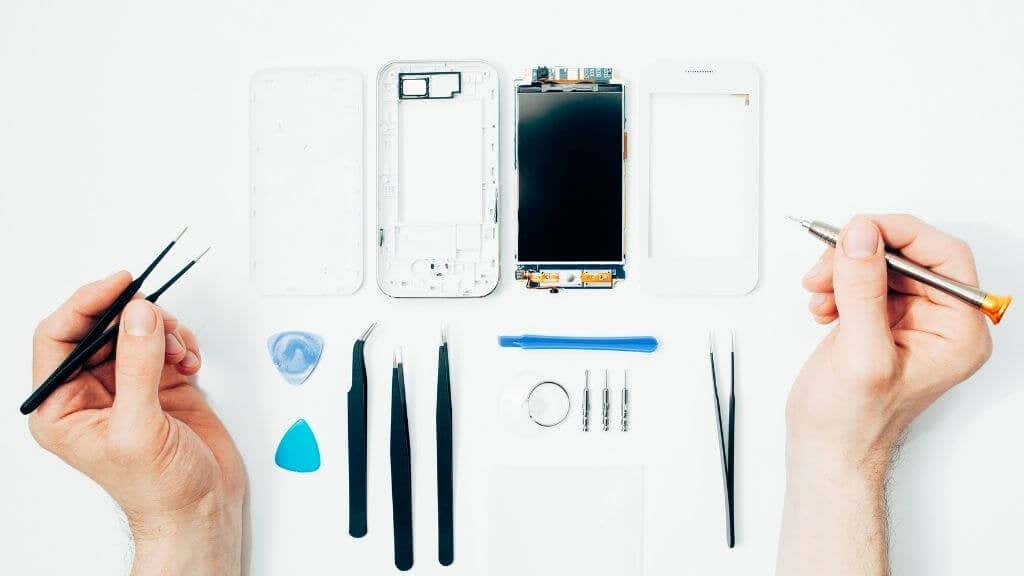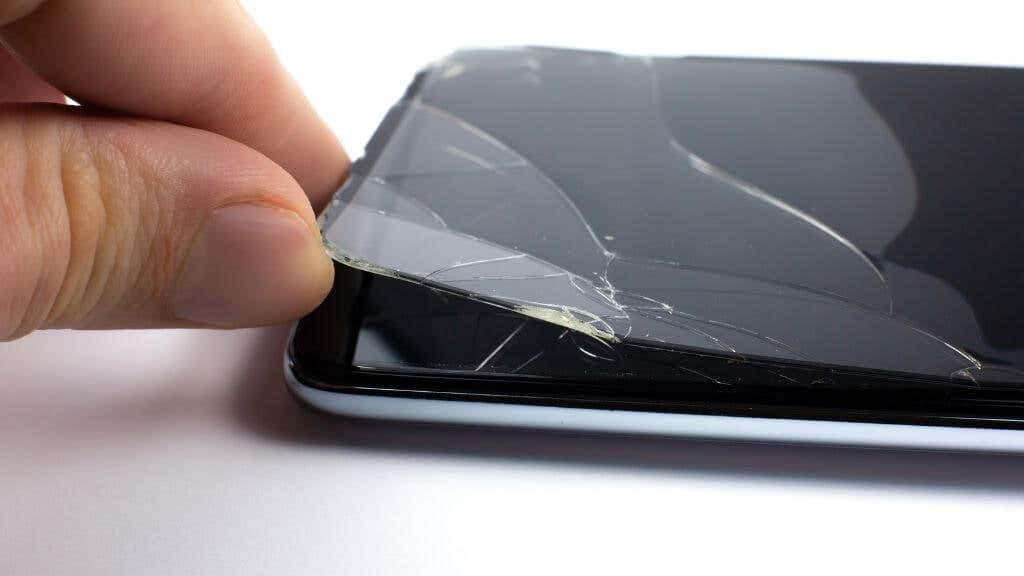We'll give you the final verdict
Smartphones are an expensive purchase, and all it takes is one bad-luck event to smash your shiny new phone’s screen into a million pieces. There must be something you can do to preserve the quality and integrity of your phone!
Cases protect your phone from drops and bumps, but screen protectors are sold as a way to protect your screen itself from damage. That sounds great on paper, but do you really need a screen protector for your phone, or are they just an expensive placebo?
Cracked Screens Are Expensive to Replace
In the old days, if you broke your phone glass, it was possible to replace it without replacing the screen, assuming it was undamaged. However, modern screen technology uses a lamination process, so there’s no gap between the screen and the glass covering it. This results in much better image quality, but it also means that if the glass is damaged or cracked, you have to replace the entire screen.
This integration has seriously inflated the cost of fixing broken phone glass and is probably why you see so many folks walking around with shattered phones—it’s just too expensive to repair. The real question is how likely you are to have your phone end up in such a state, and to understand that, we have to talk about modern phone glass for a minute.
Smartphone Glass Is Incredible
First things first: smartphone screen glass is incredibly tough. Corning’s Gorilla Glass on Android phones or Ceramic Shield Glass on the new iPhones are aggressively impact and scratch-resistant. These glasses are so hard that only minerals can scratch them. Metals, like car keys in your pocket, are unlikely to leave a mark. On the Mohs hardness scale, Gorilla Glass Victus lies somewhere between 6 and 7. Steel, for comparison, is between 4 and 4.5. This means that hard minerals like quartz can make visible scratches to this glass, but most common materials shouldn’t mark it.
Your smartphone’s glass is already more than up to the task of handling everyday use. You might pick up some micro-scratches over the lifetime of your phone, but these don’t usually impact the feel of the screen or the look of images on it.
Manufacturers also test smartphones rigorously to ensure they handle more intense abuse. Linus Tech Tips took a smartphone factory tour, and from the testing shown there, the average smartphone is built to take serious punishment while still being functional.
So at this point, we can confidently say that most people don’t need a screen protector. There are still some cases where you might want one, but you should know what you’re getting into.
Who Absolutely Should Use a Screen Protector
We think that phones without screen protectors (or cases for that matter) are acceptable to handle everyday use out of the box, but the emphasis here is on “everyday use.”
If you work in a job or have a hobby that puts your phone into situations or near materials that can defeat the toughness of its materials, then you need more protection.
Many people overlook one source of glass damage: common minerals found in beach sand or hiking trails. If some grit ends up in your pocket with your phone, it may get scratched up to the point where it’s not good to use anymore.
If you work in a job like construction or are active outdoors, you might instead consider getting a full ruggedized case for your phone instead of a screen protector. Alternatively, you could also consider phones built explicitly for these environments, such as those made by CAT.
Use Caution When Choosing a Screen Protector
There’s a surprising number of considerations in play when picking a screen protector or deciding whether you need one at all. So we’ll carefully go over the different types of protectors and complex factors you should be aware of before making your decision.
Factory-fitted Screen Protectors
Speaking of the factories that make smartphones, your phone may already have a screen protector when you first take it out of the box. For example, the Samsung Galaxy S21 Ultra has a protector applied that protects it from minor scratches. When it becomes too worn and damaged, you can remove it without any issue.
This is true for factory-fitted protectors in general. You can remove them immediately if you like and replace them with something better or nothing at all. Alternatively, you can just keep them until they need removal. What you shouldn’t do is put a new screen protector over your existing factory-fitted protector. Also, make sure what you’re seeing is a screen protector and not something important.
Screen Protectors Can Be a Pain to Fit
One advantage of a factory-fitted protector is that you don’t have to fit it yourself. This is good because screen protectors are a nightmare to fit. Not only do you have to make sure that your screen is entirely free of smudges, dirt, and hair, you also have to apply the protector straight and without trapping any air bubbles.
Whenever you buy a screen protector, it’s better to buy two. Because you’ll almost certainly mess up the application, it’s usually better to get the people from your phone store to apply it for you if you can.
Screen Protectors Are Not Made Equal
We can’t talk about screen protectors as one single type of product. There are different screen protectors, and some have more practical use than others. Some protectors do more than just protect your screen.
You can get protectors that add a matte anti-glare coating to make your phone more usable in bright conditions. Ultra-clear protectors minimize the effects of the protector on the image and filter out UV rays. On the other hand, privacy screen protectors obscure what’s on the screen to anyone except the person looking at it straight-on. So these protectors have utility beyond screen protection.
When it comes to the main job of providing extra protection for your screen, different protectors focus on it in varying ways.
Thin TPU or PET plastic screen protectors are there to prevent micro-scratches. These protectors are the least invasive and protect against the type of damage your phone is most likely to suffer during its lifetime.
Tempered glass screen protectors protect against both impacts and scratches, although they are thick and heavy compared to other protector types. While tempered glass protectors do protect against scratches thanks to their thickness, it’s debatable whether they do anything to prevent a cracked screen.
What About Self-healing Screen Protectors?
A relatively recent development in the world of screen protectors is the so-called “self-healing” screen protectors. The precise details vary depending on the brand and implementation, but within the screen protector is a tiny layer of a substance that leaks out whenever the protector is scratched, filling up the scratch.
In theory, this extends how long you can leave a screen protector on before replacing it. Whether the self-healed scratches are invisible or not depends on you, we’ve seen mixed feedback so far.
Screen Protectors Can Affect the User Experience
There’s nothing quite like using a touchscreen directly without anything between your finger and the phone. Mobile phone screens have been engineered to give you the perfect level of tactile response and offer you a crystal-clear, vibrant image using incredibly advanced manufacturing processes which fuse the screen with the touch and glass layers without damaging a single pixel in the display.
So it seems a little off to slap a $10 screen protector on top of this, undoing much of what made your phone so wonderful (and expensive) in the first place.
The tempered glass screen protectors that offer the best impact protection are also the thickest. This means your phone’s smooth curved edge now presents a sharp edge every time you swipe over the edge, and the photos from your screen are being absorbed and refracted by the thick layer of glass.
You may think that the impact is minor, but if you’ve ever used a phone right after taking off the tempered glass screen protector, you’ll know just how much better it looks and feels in comparison.
Insurance May Be a Better Solution
If you’re mainly worried about protecting your phone against minor scratches rather than cracks or breakages, then a screen protector may not be the best solution.
After all, if your phone takes an impact hard enough to shatter your tempered glass screen protector, then it’s likely to crack and break your screen anyway. So it makes more sense to save your money and spend it on phone insurance. Some phone theft insurance includes accidental damage insurance or offers a cheap add-on. The same goes for some carrier plans, which can provide insurance as part of your contract or as an add-on.
Phone makers also offer damage insurance. Applecare is a prime example, but some Android phone makers also offer similar screen-replacement offers, like Samsung Care+. You’re paying upfront to get one or two screen replacements for a few years.
Given the cost of even a single screen repair, these protection plans are a bargain. It’s not like extended warranties for gadgets like TVs which aren’t likely to suffer accidental damage. There’s a real chance that at some point in your phone’s life, you will drop it.
Wear and Tear Is Normal
Understandably, you want to keep your phone in the same condition as when new, but any object you use daily will inevitably show signs of that use. It seems a shame to use a case or apply a screen protector to your phone when it’s been designed as a sleek, high-tech device meant to be magical to the touch and in hand.
In a way, using a screen protector on high-tech devices like these is like buying a sports car and then covering the leather in plastic and rubberizing the body. Sure, you’ll prevent wear and tear to the materials, but you don’t get to enjoy the look and feel of the product.
The Resale Argument (And Why it Makes No Sense)
If your tolerance for micro-scratches is low, a thin plastic screen protector will probably help you sleep at night, but if your main reason for wanting a screen protector is to preserve your phone for resale, we think you’re doing it yourself a disservice.
First, you’re preserving a device you paid the total price for and reducing your enjoyment of it for the next owner—a buyer who may not be that bothered by a few minor scratches.

Secondly, you probably won’t get much more for your phone compared to its actual resale value with some minor scratches. Cash resale prices for phones are often much less than the phone is worth thanks to rapid depreciation and the fact that most people don’t buy phones with cash, but get them through a subsidized carrier contract.
The Final Verdict
In the end, whether you put a screen protector on your phone or not is up to you, but based on what we’ve discussed, you should keep these essential points in mind:
- Screen protectors are primarily good at preventing minor scratches that wouldn’t affect your use of a phone anyway.
- Screen protectors always impact your phone’s image quality and usability to some extent.
- You can often get screen replacement insurance or protection for very little money.
- It’s debatable whether thick tempered glass screen protectors make a difference in a fall severe enough to smash modern smartphone glass.
- If you use your phone in hazardous environments, consider a ruggedized case or phone instead.
Perhaps future smartphone glass technology will make screen protectors completely redundant, but even today they are optional.













